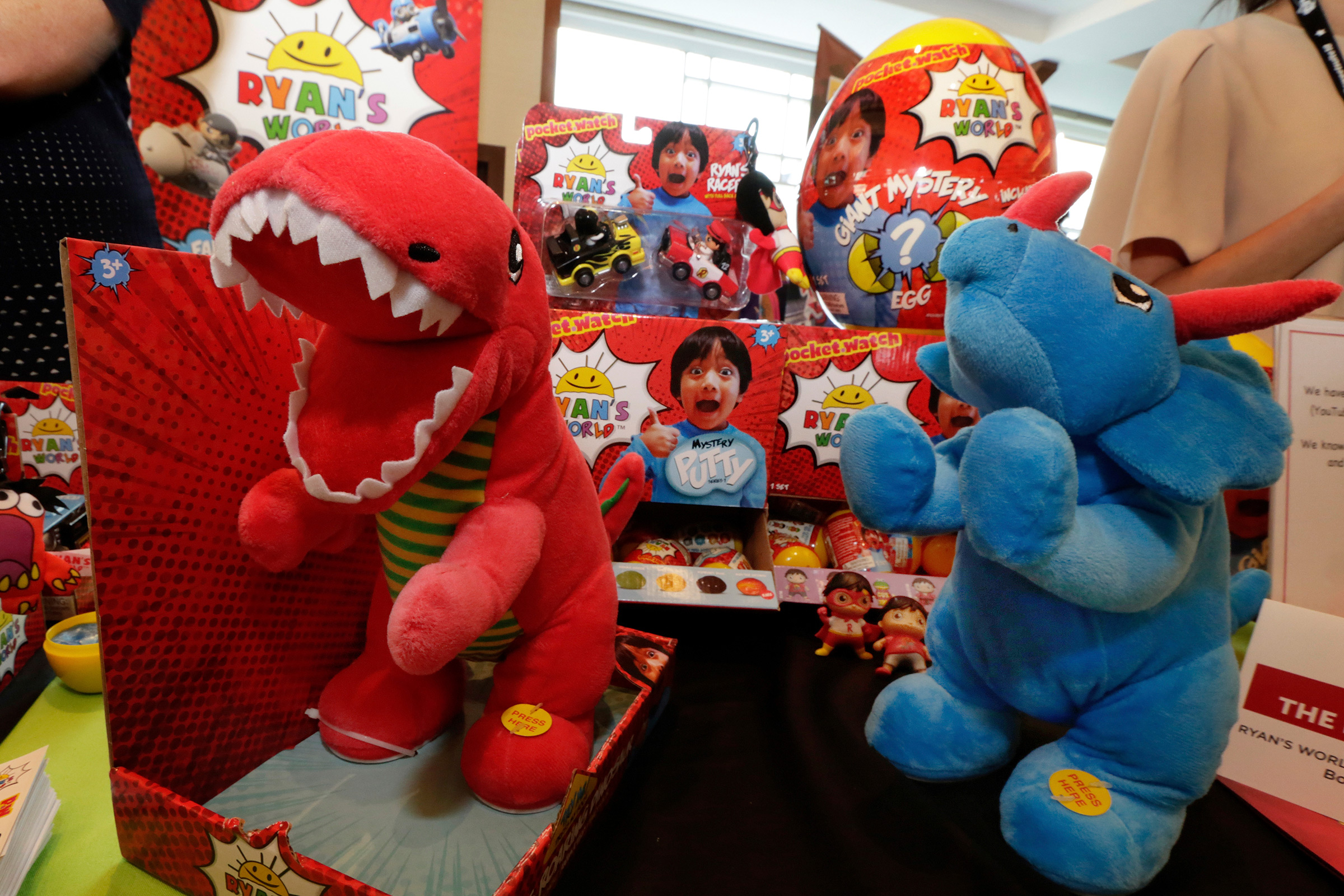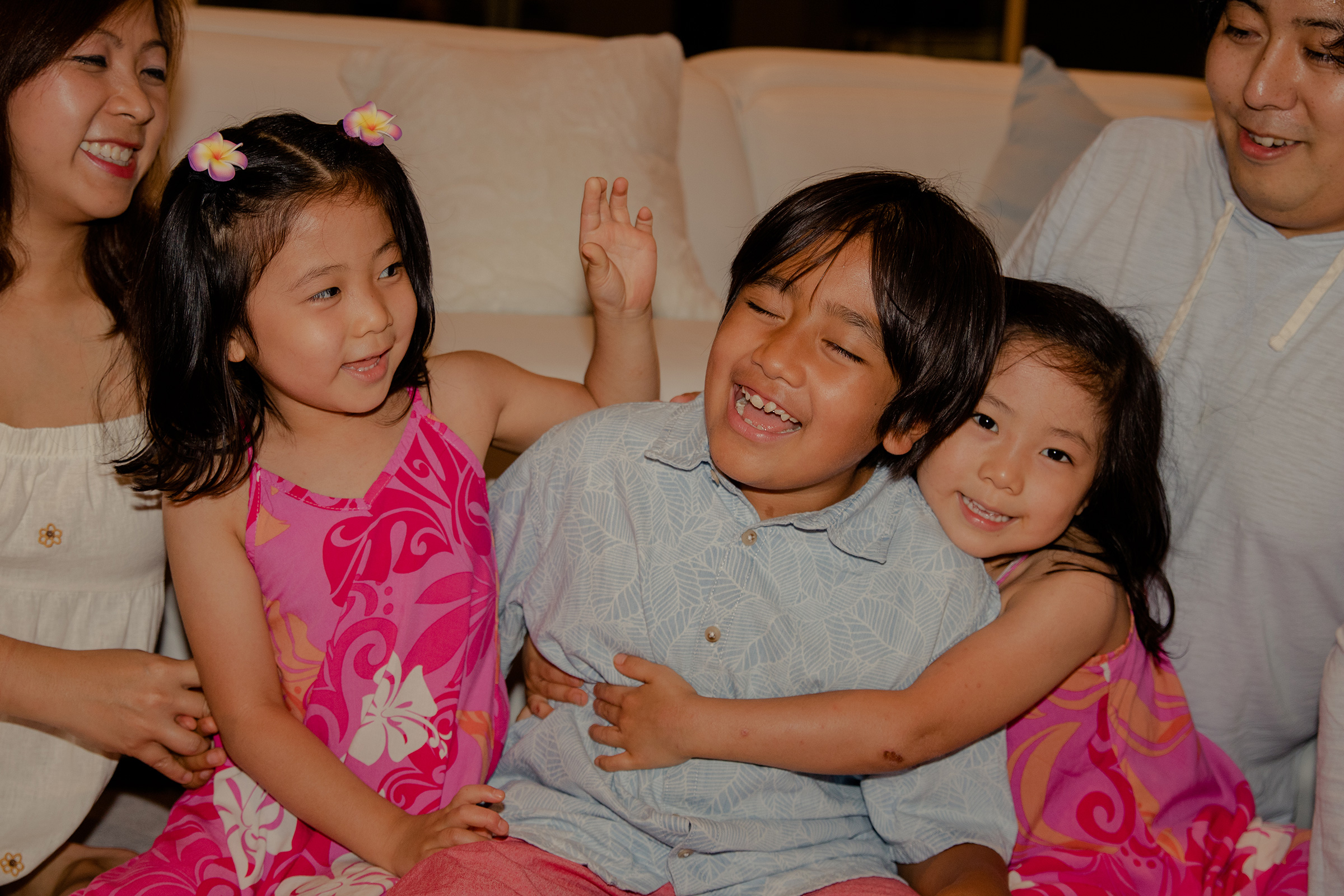
In human years, Ryan Kaji is 10. In YouTube views, he’s 48,597,844,873. If, in our digital age, a person’s life can be measured by their online footprint, Ryan’s is the size of a brachiosaur’s, which, as a lot of Ryan’s fans know, is gargantuan. Another way of putting it is that even if every one of Ryan’s YouTube views were just 30 seconds, he has been watched 4,500 times longer than he has been alive.
There’s a sacred text that talks about an era of peace and harmony, where lions lie down with lambs. The kicker is that a child is in charge of it all. Except for the part about peace and harmony, we are in an age where a child does indeed rule a significant subsection of the Internet. Ryan has been the highest paid YouTube star for three years straight, partly because he has nine channels on the platform. His revenue last year, according to Forbes, was about $30 million. Most of that was from his far-flung merchandise empire: he (or his parents) has lent his name to 1,600 licensed products in 30 countries, including Skechers, pajamas, Roblox, bedding, watches, sporting goods, water bottles, furniture, toothpaste and, of course, toys.
As well as a legion of YouTube videos, Ryan has shows on Nick Jr. (the Emmy-nominated Ryan’s Mystery Playdate) and Amazon Kids+ (Super Spy Ryan) and his own streaming channel. His animated superhero alter ego, Red Titan, will appear for the second time as a Macy’s Thanksgiving Day Parade balloon. “Ryan is bar none the crown prince of YouTube,” says Quynh Mai, founder of Moving Image & Content, a creative agency for digital content. (She does not represent him.)

How did we get to a place where a person can be the linchpin of a media empire before he has armpit hair? And of all the exuberant folks on YouTube, why has this kid raked in the most cash? Part of the answer is that this is no ordinary child, but another part is that Ryan’s rise speaks volumes about the way entertainment, business, technology and family life have changed in the past decade.
Ryan’s prominence, and the existence of the genre of human known as “kidfluencer,” is a source of consternation to many parents, authorities and child-development experts. Four of the 10 U.S. YouTube channels with the most subscribers are geared toward young children. Legislation has recently been introduced in the Senate that may curtail the activities of Ryan and his fellow YouTube toycoons. But his ascent has also shown how profoundly childhood has been and is being reshaped, and that it may be too late to put the jack back in the box.
One thing that everyone agrees on is that much of Ryan’s fame was a result of timing. He was about 3½ in 2015 when he asked his mom Loann Guan—the family changed its name to Kaji to preserve some anonymity as they got famous—if he could be on YouTube like other kids. Loann, 37, was a science teacher on spring break looking for kid-friendly activities. She and her husband Shion, 34, had watched YouTube in college and had a grasp of the format and how the algorithm worked.
Read More: Meet TIME’s First-Ever Kid of the Year
At the same time, technological changes were making online video more accessible to kids. “It was like a perfect storm when Ryan came in,” says Mai. Laptop prices had dropped enough that people were moving away from tablets. The YouTube Kids app had launched. “Parents gave their iPads to their children as entertainment devices, and that made it so easy for kids to navigate the Internet,” she says. Feeling stretched in terms of childcare, lots of parents needed to keep their kids occupied. “When young children see lots of colors and sounds and movement on a screen, it’s almost like a mobile above the crib,” says Dr. Jenny Radesky, a developmental behavioral pediatrician at the University of Michigan. “They calm down. They focus. Studies have shown that it often leads to less body movement.”
The period after 2015 also marked a growth phase for the so-called creator economy. With the advance of digital ad technology, advertisers realized they could get more traction from microtargeting followers of a regular person—an influencer—than from a celebrity. Among the most popular figures when the Kajis began were the unboxers, people who filmed themselves opening shoes or makeup, or kids opening toys.
Most Popular from TIME
So that’s what Loann and Ryan did. Ironically, Ryan had not really liked playing with toys as a baby, except one: a remote-control car, which, his dad says, he could more or less operate by the age of 6 months. This meant every relative gave him toy cars. When the unboxing trend spun off into the Giant Egg trend, Loann hid those cars in a papier-mâché egg she’d made. The resulting video, “GIANT Lightning McQueen Egg Surprise with 100+ Disney Cars Toys,” shot Ryan’s ToysReview, as the channel was then called, into the stratosphere. “That one video became his most popular video on our channel for the next two years,” says Shion. It currently has more than a billion views.
At first, strange comments below the video alarmed them. “It was all gibberish,” says Shion. Then he saw Ryan typing random letters beneath videos and realized other kids were doing that too. Some of them may not have spoken English. “We noticed a huge percentage of the viewership coming from Asia,” says Shion. Ryan’s channel had launched just as YouTube was spreading to Asia, and videos like Ryan’s filled a void that TV had overlooked. Shion was born in Japan, and Loann in Vietnam. “For a lot of minorities,” says Mai, “YouTube was the place where you saw people like you.”
Read More: I Raised Two CEOs and a Doctor. These Are My Secrets to Parenting Successful Children
Ryan’s ToysReview quickly became one of YouTube’s most popular channels. By 2016, both parents had quit their jobs to make videos full time. Shion is a Cornell-educated structural engineer, which may be why he sensed the danger of having Ryan, just 5, carry the bulk of the show. He beefed up the production team to avoid burnout and had animators create characters based on Ryan’s personality for more content. Shion and Loann also appear in the videos and play with toys and games on their own channel.
There may be a place in which one small family can produce so much intellectual property and be left in peace, but that place is not the USA, circa 2017. Ryan caught the eye of Chris Williams, who as a former Disney and Maker Studios executive had watched media habits change in real time. “I saw linear television’s ratings fall off a cliff,” he says. “I saw kids and family audiences flocking to YouTube.” His experience at Disney had also taught him about the power of building a franchise. “There are stars, characters and intellectual property on YouTube that have bigger audiences than the entire Disney Channel network. Why are we not thinking about them in the same way?” In 2017, he started Pocketwatch to do licensing deals with YouTube stars, and the Kajis, who had formed their own production company, Sunlight Entertainment, were among its first partners.
Read More: How Dr. Becky Became the Millennial Parenting Whisperer
The move came just in time. Merchandisers were not the only ones who noticed how much content was directed at the very young. Parents, child-development experts, media watchdogs and eventually legislators did too, and many didn’t love what they saw. There were videos of adults playing with toys in inappropriate ways. Some of the families on YouTube fell apart. Others seemed to be treating children badly to draw clicks.
Advertisers pulled back. YouTube removed comments sections from and kept ads off some videos. It wasn’t enough. In 2019, YouTube and its parent company Google paid $170 million to settle allegations by the Federal Trade Commission (FTC) and the New York State attorney general that it collected data about minors and violated the Children’s Online Privacy Protection Act. By 2020, YouTube required creators to specify whether their videos were for kids and stopped feeding personalized ads to those that were. Many kid-centric channels lost the bulk of their revenue. But thanks to the merch deals, the Kajis sailed on. Williams says the franchise is his company’s biggest earner.
The reforms may have lessened the problem of advertising to children, but they did nothing to change the thorny fact that watching endless hours of a child opening toys is of dubious—at best—educational or social-development value. There’s not much definitive research on what that kind of media diet does to a developing brain, but the small amount out there is dismaying. In a study out of the University of Colorado, Boulder, 78% of parents reported their kids watched unboxing videos on a regular basis, with almost 17% estimating it at between three and nine hours per week. “The more time a child spends watching unboxing videos,” says Harsha Gangadharbatla, an associate professor of advertising, who presented the paper at a journalism conference in 2019, “the more likely they are to ask for things and throw tantrums if the parents weren’t purchasing those things.”
Studies have shown that children form para-social relationships with the media figures they encounter. “They’re dealing with a developing brain that is figuring out the world,” says Dr. Michael Rich, a pediatrician and the director of the Boston Children’s Hospital’s Digital Wellness Lab. “And if one of the very powerful inputs into that developing brain is ‘Look at how happy Ryan is with his toy!’ of course they’re going to say, ‘I want that.’”
Read More: I Was Constantly Arguing With My Child. Then I Learned the “TEAM” Method of Calmer Parenting
Just before YouTube and Google paid the fine, the nonprofit Truth in Advertising (TINA) filed a complaint with the FTC against the Kajis—who then changed the name of their channel from Ryan’s ToyReview to Ryan’s World. The group had found that Ryan played with toys that would appeal to kids 5 years of age or younger in 90% of the channel’s 200 most popular videos. TINA claimed the sponsored videos were not clearly enough delineated. “Sometimes, they weren’t adequately disclosing such that an adult would know, and other times, it’s just the fact that this vulnerable population of toddlers cannot differentiate between organic content and ads,” says Bonnie Patten, TINA’s executive director. (The FTC does not talk about pending investigations.)

Williams says the Kaji family has been unfairly singled out because they offer the biggest target. He points out that they have shifted to more educational content, with science experiments and travel videos. At the same time, he is open to greater research and regulation. “I worry about the effects of all of it. Not just what we see on YouTube and other platforms, but movies and TV,” he says. “Nobody wants to do the work around researching this stuff. They just want to make proclamations: ‘Hey, it’s different from what I grew up on. It must be bad.’”
The Kajis maintain that they “follow the guidelines” for labeling their content, but, says Loann, “if I could do it over, I would try to incorporate more of the educational component right from the get-go.” A legal team screens their videos, but they do not have a child-development expert on staff.
One solution would be to take down the old unboxing videos and stop putting up new ones. After all, Sunlight Entertainment releases 25 new videos a week across its channels. But surveys show that in the U.S., “the No. 1 thing for our channel is that they still want Ryan playing with toys,” says Shion. In August, however, YouTube announced that it would remove “overly commercial content” from the YouTube Kids app and mark sponsored videos more clearly. And on Sept. 30, as Congress began to take a closer look at social media companies, Democratic Senators Edward Markey of Massachusetts and Richard Blumenthal of Connecticut reintroduced the KIDS Act, which would force sites like YouTube to stop recommending unboxing videos for kids. YouTube declined to answer specific questions from TIME, but pointed to a raft of policies, developed with child-development experts, intended to keep young viewers safe.
Nevertheless, Pandora has already completed her unboxing. Ryan’s branded toys are everywhere. And he’s not alone. There’s a new crop of stars coming, on Tik Tok, Instagram and YouTube. Vlad, 8, and Niki, 6, Russian-born brothers who live in Florida, released their first toy figures in June. Nastya, 7, also a Russian-born Floridian, launches her dolls Nov. 15. Kidfluencers no longer have to hawk toys; they can just become them.
Any discerning viewer who watches Ryan’s videos notices within a minute that they don’t offer much in the way of entertainment. The production is amateurish. There’s no narrative arc. This is intentional. The Kajis are not artists; they’re parents. They started making videos, they say, because their kid wanted to and was good at it. “We don’t really do multiple takes,” says Loann. “What I get from him, that’s what I’m going to use.”
The DIY nature of the videos also mimics, they hope, what it’s like to go on a playdate. “We don’t want the viewers to watch our videos one after the other,” says Shion. “What we ideally want is kids to watch our video and then that inspires them to have an idea for what they want to do and they put down their iPad.” At the onset of the pandemic, they put up several videos of Ryan doing homework, so kids could feel like they were studying with a friend.

It’s difficult to ascertain if kids do indeed go play after watching the videos. The fact that some Ryan’s World videos are hours long suggests that a certain amount of sedentariness is allowed, if not encouraged. Many parents loathe them; they overwhelmingly garner one-star reviews on sites like Common Sense Media. It was Ryan’s World that caused Mike Lutringer, in Houston, to swear off YouTube Kids forever. When his second daughter was born and he and his wife needed to attend to her, he’d put on an educational Ryan video for his older child. “But very rapidly it’ll transition over to marketing and sales and reviews,” he says. “You can see how they’ve designed it to really capture the attention of the child.”
Dylana Carlson, in Galesburg, Ill., on the other hand, says that during the pandemic, her two children would watch Ryan or another kidfluencer and then try to play the way they did. Occasionally they’d ask for a playdate with their Internet friend. “I think that they assume that they can just go meet these kids,” she says. “I have thought about this stuff, like, Is that depressing? Or is that weird? But corporations pay to have a dress-up Spider-Man come to the grocery store. How is this different?” Quynh Mai, the marketer, thinks this is one of the secrets of Ryan’s success. “These kids, I think, are really lonely,” she says. “Ryan provides the emotional connection.”
As online friends go, Ryan is a Hallmark-level cherub. He appears to have a bottomless vat of enthusiasm for any toy/room/situation he encounters. In interviews, he is cheerful and eager, with an age-appropriate inability to be self-reflective. He loves school, especially math! He swims, plays soccer, does tae kwon do, but gymnastics is his favorite! He hates when he can’t find his lunch box! If he could have any superpower, it would be super speed! When he grows up, he wants to be a “game developer or a comedian who is a YouTuber who makes funny videos!”
During the pandemic, Loann homeschooled the kids, and when the Kajis tested Ryan to see if he had fallen behind, they found he was several grades ahead. One of the reasons they moved to Hawaii this year is for a more academically challenging school than his public school in Houston. The other, interestingly, is that they felt the kids were spending too much time on screens. In Hawaii, they take more walks, which Ryan at first found exhausting. He’s also learning piano and Japanese, but he’s not crazy about either.

There are two ways to look at the Kaji parents. One is that they have dragooned their offspring into living out their lives on camera to get rich. The other, the one they present, is that they stumbled into a world where their child became a star and they tried to keep up. Ryan’s onscreen ability, they say, is as big a surprise to them as to anyone. He often takes a video in a new direction during shooting, telling the editors what effects to add as he goes. “On or off camera he is the exact same way,” says Shion. “He genuinely connects with his viewers.” Lest anyone think that’s pure parental boasting, Loann says Ryan’s 5-year-old twin sisters also love making videos, but “it’s not as natural to them.” (Yes, they already have their own line of toys.)
The journey hasn’t always been a thrill ride. In 2003, Loann spent a month in jail for shoplifting, and after Ryan got famous, her arrest record became public knowledge. The family did exactly one in-person event with Ryan, in Bentonville, Ark. Thousands of families turned out, and the resulting melee shook them up. They reject the accusation that Ryan is their workhorse. Loann cites an incident on the set of Playdate when Ryan hurt his ankle. The production adjusted the scenes he’d shoot so he could sit and, after a break, kept filming. Loann agreed with the decision, but adds that “if that happens at home, we would not be filming for the next week or two.” The Kajis also say that while the family will go to L.A. for a spell to shoot his shows, Ryan’s YouTube videos take just a few hours a week. He belongs to local sports clubs and goes to school like other kids.
What most worries Shion are families who try to emulate the Kajis’ success more recklessly. Ryan is the public face of kidfluencers, so any YouTube parent who is less than exemplary might reflect badly on him. Pocketwatch and YouTube issue manuals on how to be both parent and programmer, and Shion hints that he’s trying to start a working group of YouTube families to set industry standards. He won’t go into details, but says he would like more input from YouTube, especially on how families manage their finances, their kids’ time and fame. After all, the platform is taking a healthy cut of the money, and the minors who have made their name on it have few legal protections. The Kajis say a portion of the revenue from the family business goes into trust accounts they’ve established for their children, and they have put all of Ryan’s TV earnings into another trust.
There are children on YouTube now with more subscribers than Ryan. His parents seem somewhat relieved. “I don’t want YouTube to be his future career,” says Loann. “We really want him to do something else. We’re continuing right now because he’s enjoying doing it.” The question remains: having found the perfect platform for their child, can they persuade him to leave it? —With reporting by Simmone Shah and Nik Popli
More Must-Reads from TIME
- Cybersecurity Experts Are Sounding the Alarm on DOGE
- Meet the 2025 Women of the Year
- The Harsh Truth About Disability Inclusion
- Why Do More Young Adults Have Cancer?
- Colman Domingo Leads With Radical Love
- How to Get Better at Doing Things Alone
- Michelle Zauner Stares Down the Darkness
Contact us at letters@time.com



